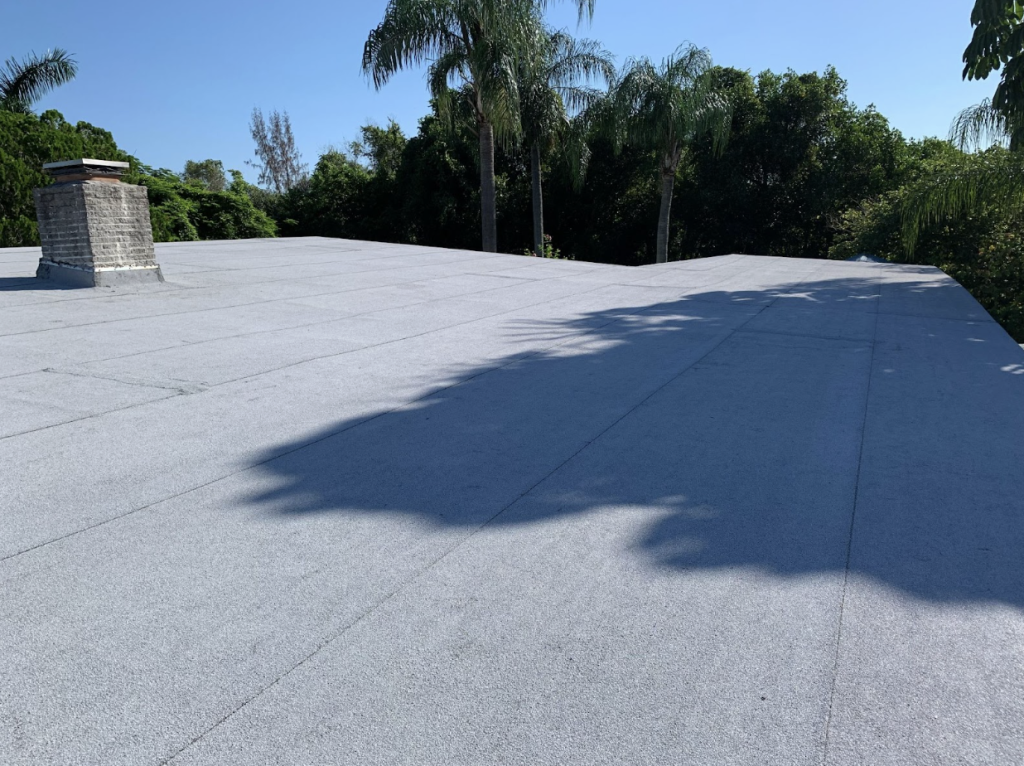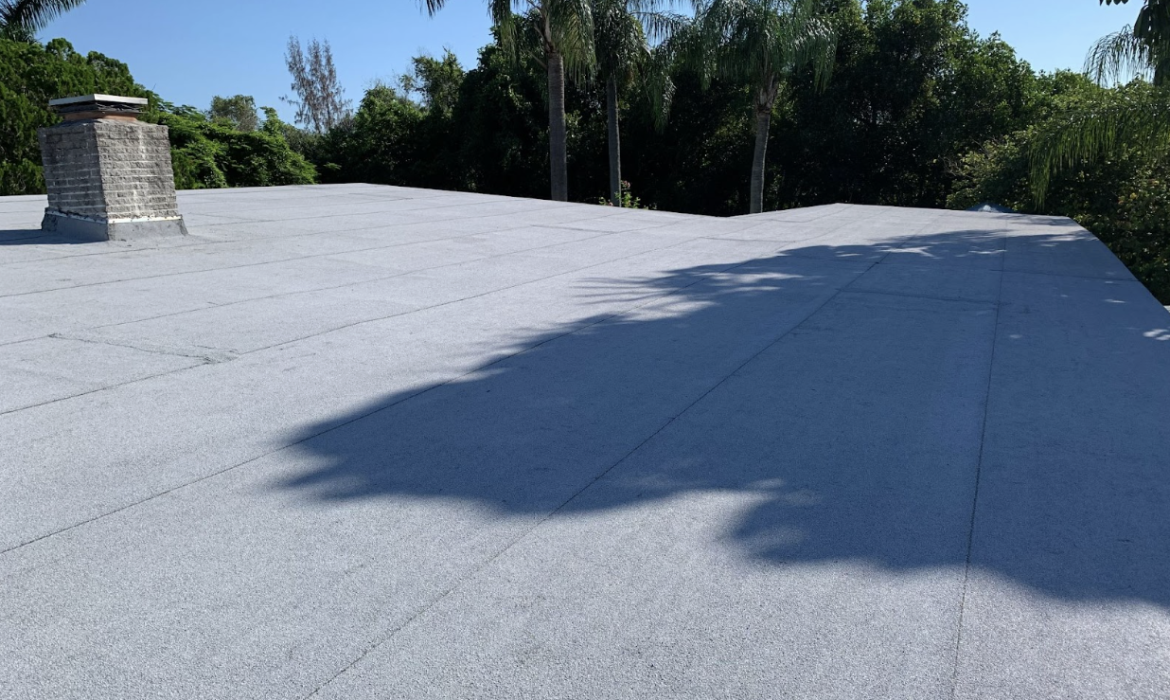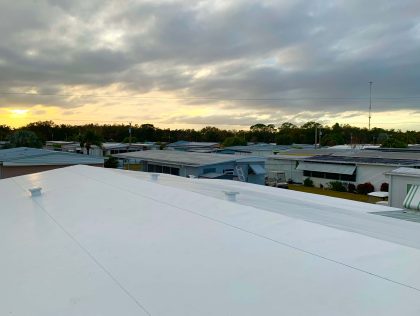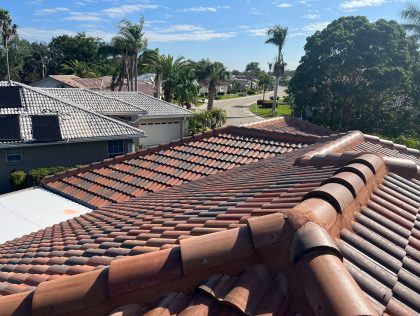Thinking of making the switch to modified bitumen roofing? You’re probably here to learn all about it like every responsible homeowner would. The modified bitumen roof is one roofing option that has gained popularity in recent years for its resilience and reliability. In terms of roofing systems, longevity and durability are indeed critical factors.
In this article, we’re breaking down what modified bitumen roofing is, its composition, its benefits, and, most importantly, how long you can expect it to last. By the end of this post, you’ll know everything you need to know about modified bitumen roofing before you commit!

What Are Modified Bitumen Roofs Made of?
Asphalt-based modified bitumen roofing systems are made especially for structures with flat or low-slope roofs. Their remarkable durability and resistance to harsh environmental elements make them a top choice for many commercial and residential properties.
These roofing systems consist of a five-layer system, each playing a crucial role in providing exceptional performance:
- Insulation: The base layer of a modified bitumen roof is insulation(optional). T layer provides thermal resistance and helps maintain the roofing system’s temperature. Equate insulation is essential for energy efficiency and temperature control within the building.
- Modified Base Sheets or Plies: Above the insulation are modified base sheets or plies. These sheets are reinforced with materials like polyester or fiberglass and are designed to enhance the overall strength and stability of the roofing system.
- Factory-Fabricated Bitumen Membranes: The core of the modified bitumen roofing system consists of factory-fabricated bitumen membranes. These membranes comprise a co-polymer-modified asphalt reinforced with either polyester or fiberglass. The combination results in a strong and durable roofing material that can withstand years of exposure to the elements.
- Waterproof Adhesive: To ensure a watertight seal, a waterproof adhesive is applied, either hot or cold, depending on the specific installation method. T is an adhesive that helps to bond the layers together, preventing water from infiltrating the roofing system.
- Special Surfacing: The top layer of a modified bitumen roof is a special mineral surfacing material that provides UV protection and weathering resistance. This layer protects the roofing system from the sun’s rays, delaying damage and premature aging.
What Advantages Do Modified Bitumen Roofs Offer?
Modified bitumen roofing offers several key advantages that have contributed to its popularity in the roofing industry:
- Low Maintenance: These roofing systems require minimal maintenance over their lifespan. Routine inspections and minor repairs are usually sufficient to keep them in optimal condition.
- Energy Efficiency: Excellent energy efficiency is provided by the insulation layer in modified bitumen roofing systems, which lowers the building’s heating and cooling expenses.
- Versatility: Modified bitumen roofing can be installed on various structures, including commercial and residential buildings. It is also compatible with different roofing styles and designs.
- Cost-Effective: Modified bitumen roofing is an appealing option for property owners due to its long-term cost-effectiveness, even though the initial installation cost may be marginally greater than that of other roofing materials.
How Long Will a Modified Bitumen Roof Last?
Modified Bitumen Roofs are known to last around 20 years or even slightly more when maintained properly. That being said, factors like the quality of the materials used, the methods of installation, and upkeep are the key determinants of a modified bitumen roof’s longevity.
Regular inspections assist in locating and resolving minor concerns before they become larger. However, some roofs have exceeded this range with proper care and regular inspections.
To ensure the maximum lifespan of your modified bitumen roof, it’s crucial to engage a reputable roofing contractor for installation and periodic maintenance. Inspections regularly help find small problems and fix them before they become bigger.
What is the difference between TPO and Modified Bitumen?
Here’s a comparison between TPO (Thermoplastic Poly Olefin) roofing and Modified Bitumen roofing:
TPO Roofing:
- Made of a blend of rubber and plastic.
- Single-ply membrane with heat-welded seams.
- Resistant to UV rays and chemicals.
- Low maintenance and energy-efficient.
- The initial cost may be higher, but it is cost-effective in the long.
- Insulation can easily be added underneath
Modified Bitumen Roofing:
- Asphalt-based material with multiple layers.
- Installed in layers with adhesives or torches.
- Highly durable and suitable for harsh climates.
- Requires more maintenance but offers good insulation.
- Cost-effective option.
Choose based on your budget, climate, and specific project requirements.
Conclusion
Modified bitumen roofing is a robust and reliable option for low-slope or flat-roof structures. Its five-layer composition and resistance to environmental factors make it a wise choice for property owners looking for a long-lasting roofing solution.
Your modified bitumen roof should last you for many years, protecting your property and giving you peace of mind if the correct installation and upkeep are done.
If you’re considering a modified bitumen roof for your property, trust the experts at Phoenix Contracting of SWFL, LLC. Our experienced team specializes in top-quality roofing installations, including modified bitumen systems.
For a consultation and to learn how our experience can improve the lifespan and functionality of your roof get in touch with Phoenix Contracting of SWFL, LLC right now.



